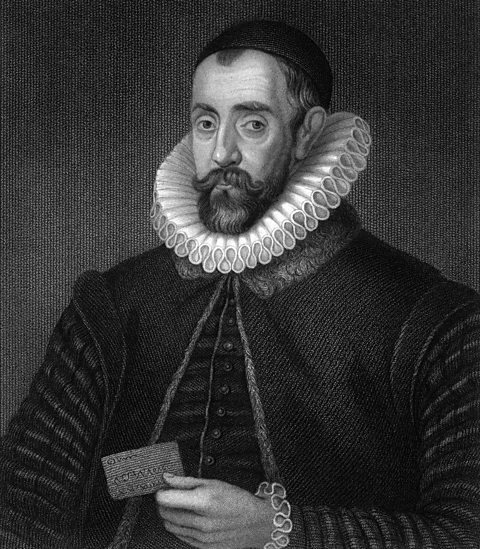The Puritan threat

Puritans were strict ProtestantChristians who broke away from the Roman Catholic Church during the Reformation. They believe in the teachings of the Bible but reject the authority of the Pope. who wanted to āpurifyā the Church and get rid of all traces of the CatholicThe Church in Western Europe before the Reformation. The Pope was head of the Church. A member of the Roman Catholic Church. faith. Many had fled abroad when Mary I, a Catholic, was queen, but had started to return when Elizabeth, a Protestant, came to the throne. Elizabethās Religious SettlementThis was an attempt made by Elizabeth I in 1559 to end the conflict in England between Catholics and Protestants and unite the country. meant that the country was now officially Protestant, but allowed some traditions of Catholic worship. At first many Puritans seemed to accept the Settlement, but they soon started organising campaigns to make it more Protestant.
How much of a threat were the Puritans?
They raised their points in Parliament, but did not on the whole get involved in plots to overthrow Elizabeth or destabilise the country and were therefore seen as less of a threat than the Catholics.
Some of Elizabeth's most trusted Privy CouncilA group of senior politicians who advise the monarch. and MPsMembers of Parliament., notably Robert Dudley, Earl of Leicester and Sir Francis Walsingham, were Puritans and tried to pressure her into taking harsher steps against Catholics.
Even if they weren't a great threat, Elizabeth still did not welcome the Puritans' challenge to her authority.
Puritan threats
| Date | Puritan threat | Elizabethās action |
| 1571 | Walter Strickland, leader of the Puritan group in Parliament, wanted to reform Elizabethās new Prayer Book and ban clergy vestments (this was known as the Vestarian Controversy). | Elizabeth silenced him by closing Parliament so his ideas could not be discussed. |
| 1575-83 | Some Puritan clergy started organising prayer meetings known as āprophesyingsā which displeased Elizabeth. In these meetings Puritans took a freer approach to prayer and did not follow what Elizabeth had specified. She was concerned ideas might spread that challenged the religious settlement. | Elizabeth ordered her new Archbishop of Canterbury, Edmund Grindal, to ban the meetings but he protested. She suspended him, suggested he resign, and 200 Puritan priests were expelled from their roles. |
| 1583 | The Puritan, John Stubbs, published a pamphlet criticising Elizabethās on-going marriage negotiations with the brother of the Catholic French king. | Stubbs was found guilty of stirring up trouble and sentenced to have had his right hand cut off. |
| Date | 1571 |
|---|---|
| Puritan threat | Walter Strickland, leader of the Puritan group in Parliament, wanted to reform Elizabethās new Prayer Book and ban clergy vestments (this was known as the Vestarian Controversy). |
| Elizabethās action | Elizabeth silenced him by closing Parliament so his ideas could not be discussed. |
| Date | 1575-83 |
|---|---|
| Puritan threat | Some Puritan clergy started organising prayer meetings known as āprophesyingsā which displeased Elizabeth. In these meetings Puritans took a freer approach to prayer and did not follow what Elizabeth had specified. She was concerned ideas might spread that challenged the religious settlement. |
| Elizabethās action | Elizabeth ordered her new Archbishop of Canterbury, Edmund Grindal, to ban the meetings but he protested. She suspended him, suggested he resign, and 200 Puritan priests were expelled from their roles. |
| Date | 1583 |
|---|---|
| Puritan threat | The Puritan, John Stubbs, published a pamphlet criticising Elizabethās on-going marriage negotiations with the brother of the Catholic French king. |
| Elizabethās action | Stubbs was found guilty of stirring up trouble and sentenced to have had his right hand cut off. |
Elizabeth held strong against the Puritan attempts to get her to change the Religious Settlement and the movement lost momentum towards the end of her reign as, one by one, the old Puritan leaders died. By 1590 most of the people accepted the Church of England as the national Church.
More guides on this topic
- The Elizabethans overview - Edexcel
- The early rule of Queen Elizabeth I - Edexcel
- Queen Elizabeth I's early rule quiz
- Queen Elizabeth I's Religious Settlement quiz
- Challenges to Elizabeth's rule - Edexcel
- Challenges to Queen Elizabeth I's rule quiz
- Life in Elizabethan England - Edexcel
- Life in Elizabethan times quiz
- The Elizabethans - exam preparation - Edexcel